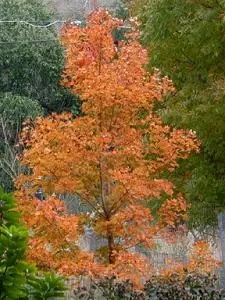NICE! Plant of the Month
(Acer grandidentatum)

Description:
Bigtooth maple is a relic from the last ice age, 10,000 years ago. It is a native hardwood shrub or medium sized-tree of 20-30 feet, but under optimal conditions it can reach up to 50 feet tall. It has an open, rounded crown and usually a single trunk of one foot diameter or less. The simple, deciduous, opposite leaves are either 3 or 5 lobed and 2-5” long. Normally, these maples occur only as isolated populations, “lost” from each other, in widely separated moist canyons of central Texas (including just on the edge of Boerne), the Chisos and Guadalupe Mountains of west Texas, southward into northern Mexico and into the Rocky Mountains as far north as Idaho. Inconspicuous flowering occurs during spring with leaf emergence. The fruit is a typical maple samara that ripens in the late summer. When conditions are right in the fall, the Bigtooth maple puts on a foliage color display that is rivaled by none. The brilliant leaf colors range from clear yellow to vivid orange and crisp red to warm maroon. This striking tree draw huge crowds from across Texas to their isolated locations during the height of their color display in late October to early November.
Deer Resistance:
Young trees are readily browsed and should be protected by caging until the foliage is out of reach of deer and the trunk is rigid.
Planting Sites:
Bigtooth maples adapt well to most planting sites and all soil types in the Hill Country. This includes thin, alkaline rocky soils as long as there is good drainage. Plant them in full sun to part shade. They may do better if protected from the strong afternoon sunlight.
Planting Instructions:
Dig planting hole at least 2-5 times wider than, but the same depth as the root ball in the nursery container. Wider holes encourage rapid root growth. Carefully remove plant from container, taking care not to break the root ball. Loosen exterior roots, if root bound. Place the root ball into hole and refill with material dug from the hole. Do not add any soil to the top of root ball. Apply 4-5 inches of mulch or a thin 1-2 inch layer of compost over the root ball and the surrounding area covering at least 3-5 times the width of the loosened soil. Do not allow the mulch to touch the bottom few inches of the trunk. When planting more than one specimen, space plants 15-20 feet apart, depending on the desired mature appearance.
The bark of the Bigtooth is very thin and easily damaged. Care should be taken to control weeds around the tree by some method other than by “weed eaters.” Weed-eater damage can girdle the trunk and kill the young maple tree.
Watering Instructions:
Water in well after planting. An organic-based root stimulator used according to product directions, may be used. Repeat watering a few days after planting. Water deeply every 7-10 days, after checking an inch or two into soil at edge of root ball to determine soil moisture. Skip a watering after a rain of ½ to 1 inch. Maintain this watering schedule until the first fall after planting. Reduce water during fall and winter. In a “normal” year, no watering may be necessary in fall and winter, but during a dry period, monthly watering even in winter is desirable. Bigtooth maple is very drought tolerance once established.
NICE! Tip:
This tree is a must for the local landscape. It is virtually disease and pest resistant. With proper planting, fertilization and care, it will grow 3-4’ per year once established. These trees live for hundreds of years! Do yourself a favor. Diversify your landscape and plant your own color display so you don’t have to get stuck in the traffic during the fall to get a glimpse of the Bigtooth’s beauty! Have your neighbor plant one, too.
Look for the NICE! Plant of the Month signs and information sheets on your next visit to a participating Boerne nursery. And thank you for supporting native plants by using them in your landscapes.


